The AIM-120 Advanced Medium-Range Air-to-Air Missile(AMRAAM) ( AM-ram) is an American beyond-visual-range air-to-air missile capable of all-weather day-and-night operations. It uses active transmit-receive radar guidance instead of semi-active receive-only radar guidance. When an AMRAAM missile is launched, NATO pilots use the brevity code "Fox Three".
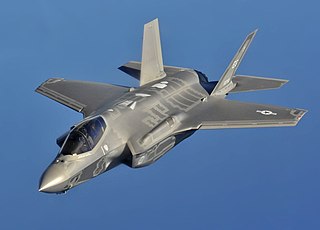
The Lockheed Martin F-35 Lightning II is an American family of single-seat, single-engine, all-weather stealth multirole combat aircraft designed for air superiority and strike missions; it also has electronic warfare and intelligence, surveillance, and reconnaissance capabilities. Lockheed Martin is the prime F-35 contractor with principal partners Northrop Grumman and BAE Systems. The aircraft has three main variants: the conventional takeoff and landing (CTOL) F-35A, the short take-off and vertical-landing (STOVL) F-35B, and the carrier-based (CV/CATOBAR) F-35C.
The GBU-10 Paveway II is an American Paveway-series laser-guided bomb, based on the Mk 84 general-purpose bomb, but with laser seeking capabilities and wings for guidance. Introduced into service c. 1976, it is used today by USAF, US Navy, US Marine Corps, Royal Australian Air Force and various NATO air forces.
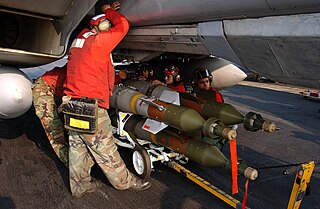
The GBU-12 Paveway II is an American aerial laser-guided bomb, based on the Mk 82 500-pound (227 kg) general-purpose bomb, but with the addition of a nose-mounted laser seeker and fins for guidance. A member of the Paveway series of weapons, Paveway II entered into service c. 1976. It is currently in service with the U.S. Air Force, U.S. Navy, U.S. Marine Corps, and various other air forces.
The GBU-28 is a 4,000-pound (1814.3 kg) class laser-guided "bunker busting" bomb produced originally by the Watervliet Arsenal, Watervliet, New York. It was designed, manufactured, and deployed in less than three weeks due to an urgent need during Operation Desert Storm to penetrate hardened Iraqi command centers located deep underground. Only two of the weapons were dropped in Desert Storm, both by F-111Fs. One GBU-28 was dropped during Operation Iraqi Freedom.
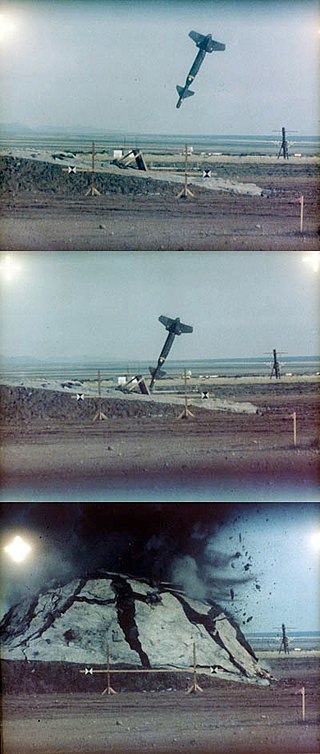
GBU-24 Paveway III or simply GBU-24 is a family of laser-guided bombs, a sub-group of the larger Raytheon Paveway III family of weapons. The Paveway guidance package consists of a seeker package attached to the nose of the weapon, and a wing kit attached to the rear to provide stability and greater range.

The Rockwell International Guided Bomb Unit 15 is an unpowered glide weapon used to destroy high-value enemy targets. It was designed for use with F-15E Strike Eagle, F-111 'Aardvark' and F-4 Phantom II aircraft. The GBU-15 has long-range maritime anti-ship capability with the B-52 Stratofortress.
The Joint Direct Attack Munition (JDAM) is a guidance kit that converts unguided bombs, or "dumb bombs", into all-weather precision-guided munitions. JDAM-equipped bombs are guided by an integrated inertial guidance system coupled to a Global Positioning System (GPS) receiver, giving them a published range of up to 15 nautical miles (28 km). JDAM-equipped bombs range from 500 to 2,000 pounds. The JDAM's guidance system was jointly developed by the United States Air Force and United States Navy, hence the "joint" in JDAM. When installed on a bomb, the JDAM kit is given a GBU identifier, superseding the Mark 80 or BLU nomenclature of the bomb to which it is attached.

Paveway is a series of laser-guided bombs (LGBs).

The McDonnell DouglasF-15E Strike Eagle is an American all-weather multirole strike fighter derived from the McDonnell Douglas F-15 Eagle. The F-15E was designed in the 1980s for long-range, high-speed interdiction without relying on escort or electronic-warfare aircraft. United States Air Force (USAF) F-15E Strike Eagles can be generally distinguished from other US Eagle variants by darker aircraft camouflage, conformal fuel tanks (CFTs) mounted along the engine intake ramps and a tandem-seat cockpit.

The AGM-154 Joint Standoff Weapon (JSOW) is a glide bomb that resulted from a joint venture between the United States Navy and Air Force to deploy a standardized medium range precision guided weapon, especially for engagement of defended targets from outside the range of standard anti-aircraft defenses, thereby increasing aircraft survivability and minimizing friendly losses. It is intended to be used against soft targets such as parked aircraft, trucks, armored personnel carriers (APCs), and surface-to-air missile sites (SAMs). Prior to launch, it is given a destination through either a predesignated waypoint or a point marked through a targeting pod. It glides, using two wings that pop out for added lift, to the marked destination and dispenses submunitions in a short, roughly linear pattern. The designation of the Joint Standoff Weapon as an "air-to-ground missile" is a misnomer, as it is an unpowered bomb with guidance avionics, similar to the older GBU-15.
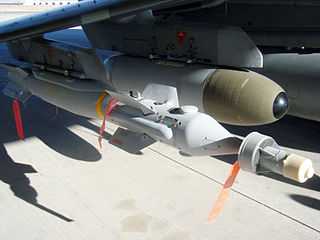
Paveway IV is a dual mode GPS/INS and laser-guided bomb manufactured by Raytheon UK. It is the latest iteration of the Paveway series.

The "SPICE" is an Israeli-developed, EO/GPS- guidance kit used for converting air-droppable unguided bombs into precision-guided bombs.

A guided bomb is a precision-guided munition designed to achieve a smaller circular error probable (CEP).

The AGM-176 Griffin is a lightweight, precision-guided munition developed by Raytheon. It can be launched from the ground or air as a rocket-powered missile or dropped from the air as a guided bomb. It carries a relatively small warhead, and was designed to be a precision low-collateral damage weapon for irregular warfare. It has been used in combat by the United States military during the War in Afghanistan.

A precision-guided munition is a guided munition intended to hit a specific target, to minimize collateral damage and increase lethality against intended targets. During the First Gulf War guided munitions accounted for only 9% of weapons fired, but accounted for 75% of all successful hits. Despite guided weapons generally being used on more difficult targets, they were still 35 times more likely to destroy their targets per weapon dropped.

The GBU-39/B Small Diameter Bomb (SDB) is a 250-pound (110 kg) precision-guided glide bomb that is intended to provide aircraft with the ability to carry a higher number of more accurate bombs. Most US Air Force aircraft will be able to carry a pack of four SDBs in place of a single 2,000-pound (910 kg) bomb. It first entered service in 2006. The Ground Launched Small Diameter Bomb (GLSDB) was later developed to enable the SDB to be launched from a variety of ground launchers and configurations.
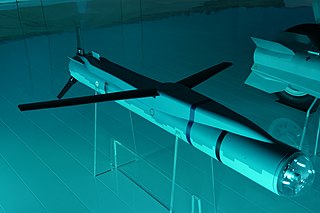
The Select Precision Effects At Range (SPEAR) Capability 3, or simply referred to as SPEAR 3 is a future British air-to-ground and possibly anti-ship cruise missile that could also be considered a loitering munition. It is currently planned to be integrated on the Eurofighter Typhoon, F-35B Lightning and possibly Tempest.

The Ground Launched Small Diameter Bomb (GLSDB) is a weapon developed by Boeing and the Saab Group to allow Boeing's GBU-39 Small Diameter Bomb (SDB), originally developed for use by aircraft, to be ground-launched from a variety of launchers and configurations. It combines the SDB with the M26 rocket, enabling it to be launched from ground-based missile systems such as the M270 Multiple Launch Rocket System and M142 HIMARS. It can also be fired from its own launch container, allowing it to be fired from sea.
The Multi-mission Affordable Capacity Effector (MACE) is a planned U.S. Navy air-launched anti-ship cruise missile intended to focus on cost-effectiveness, extended range and increased lethality. It has been described as essentially a "miniature cruise missile." It is designed as an air-launched weapon with adequate stand-off ranges to enable lethality while minimizing significant survivability risks to manned platforms. It will be launched from the F/A-18E/F Super Hornet, F-35A and F-35C, and it's intended range and usage will complement the Long Range Anti-Ship Missile (LRASM) currently fielded on the U.S. Navy's F/A-18 and the U.S. Air Force's B-1B platforms. The design requirements state that four All-up Rounds (AURs) should be able to be carried internally on the F-35, in addition to external (pylon) carry. The Navy is interested in producing at least 500 missiles per year and would begin fielding an early version in FY2027. The cost per AUR is required to be no greater than $300,000. Production is also required to utilize digital engineering, WOSA compliance and design for export capability "that results in a modular weapon system capable of integrating alternative seekers, payloads and other subcomponents for different weapons variants as well as affordable upgrades to outpace adversaries without disrupting production throughput." Defense analysts have noted that the MACE request bears similarities to the Air Force's request for the Extended Range Attack Munition (ERAM).















